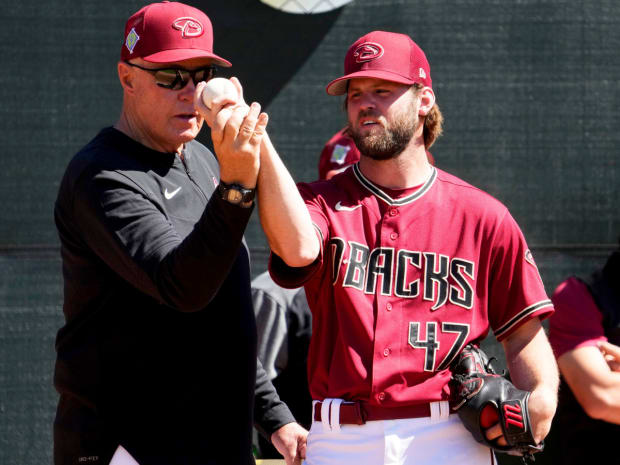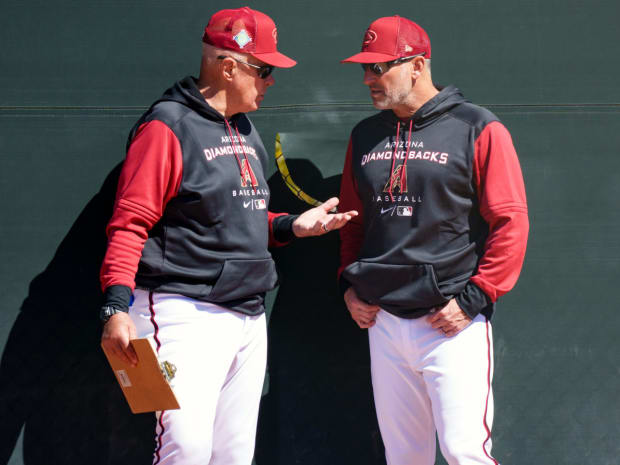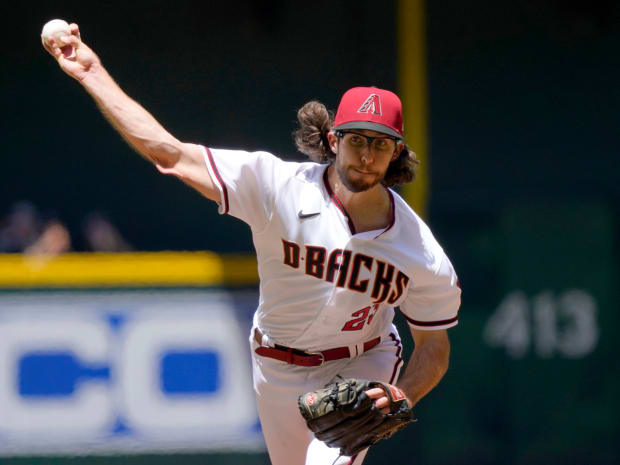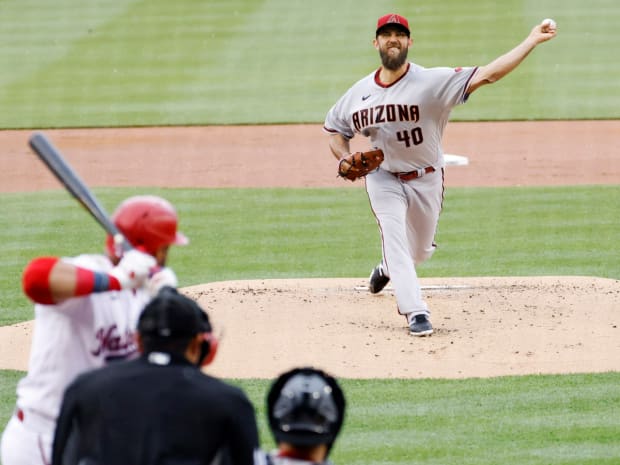Welcome to The Opener, where every weekday morning during the regular season you’ll get a fresh, topical story to start your day from one of SI.com’s MLB writers.
On the northern shores of the Sea of Cortez in the Mexican town of Puerto Peñasco, a beachfront condo sits as empty as a dream deferred. The water still laps the dune-backed sandy beach, the temperature still averages 85 degrees this month with not a drop of rain, the fishing boats still unload their catches of snapper and halibut and the craftspeople still sell their trinkets of shell jewelry and carved ironwood. But the condo owner, Brent Strom, is not there to enjoy any of it. At 73 years old, he would rather be trying to fix the worst team in baseball.
“It was intriguing to me,” he says. “I wanted the challenge.”

Rob Schumacher/The Republic/USA TODAY Sports Network
Just over a month into the season, the Diamondbacks (15–14) are one of the biggest surprises in baseball. Last year they lost 110 games, as did the Orioles. Only 10 previous teams lost that many games since the advent of the 162-game schedule in 1961. None of those 10 teams won more than 77 games the next year.
That Arizona could even fathom a record bounceback is a credit to convincing Strom that the condo could wait. In this age of technology, the Diamondbacks wanted the oldest pitching coach in baseball (five years running), a guy who’s been around so long he played for Yogi Berra and with Tom Seaver and faced Roberto Clemente. He also happens to be as savvy with data as the latest statistical engineer out of M.I.T.
When Strom, for instance, explored what he was getting himself into, one statistic jumped out.
“They were dead last in elevated heaters last year!” he says.
That, and so much more, has changed under Strom, especially with the D-Backs’ top three starting pitchers, Merrill Kelly, Zac Gallen and Madison Bumgarner. Kelly is throwing fewer fastballs and getting more chase swings, Gallen is elevating his four-seamer out of a new, Verlander-esque delivery, and Bumgarner has rediscovered his cutter by changing where he stands on the rubber.
Entering Monday, the top three Arizona starters are 6–2 with a 1.21 ERA while allowing three home runs to 354 batters. Overall, the Diamondbacks under Strom have posted a 3.33 ERA, which is ninth in MLB and a huge improvement from last season (5.11), when only the Orioles had a worse staff.
Strom took over essentially the same staff that last season became the first NL group ever to lose 110 games and yield 200 homers. (The only new investments totaled just $20.5 million for veterans Zach Davies, Ian Kennedy and Mark Melancon.) By putting his retirement on hold, Strom has burnished his reputation as a pitching whisperer of the highest order. He belongs in the company of Johnny Sain and Dave Duncan among the most renowned pitching coaches. From 2015 to '21 with the Astros, Strom’s staffs led the AL in wins, strikeouts and ERA while allowing the fewest hits and winning three pennants, two Cy Young Awards and one World Series.
Technically, Strom did retire, if only for a few days. With six weeks remaining last season, Strom informed Houston GM James Click that he was retiring after the season. He and his wife, Carrie, had bought the condo and established residency in Puerto Peñasco, the small strip of land known as “Arizona’s Beach,” given that it is the closest beach to their home in Tucson. Strom had spent 52 years in professional baseball, the last eight as pitching coach of the Astros, including 81 postseason games.
“I planned on going to the beach,” Strom says. “I felt it was time to move on. I don’t know if it was the length of the postseasons every year, but I was fatigued and tired. It was nothing the Astros did. My leaving was very cordial. No animosity.”
On Nov. 4, two days after Houston lost World Series Game 6 to the Braves, Strom was driving to a wedding in South Texas when his telephone rang. It was Torey Lovullo, manager of the Diamondbacks. Lovullo told Strom he wanted to hire him. Arizona was the only team to call. All other clubs assumed he was retired. Three days later, Lovullo and Strom met in Tucson. Strom quickly chose the job over the beach.
And Carrie?
“She was all for it,” he says. “She’s been around me long enough to know I’d probably go crazy doing nothing. The proximity [to Tucson] helped.”

Mark Henle/The Republic/USA TODAY Sports Network
The lockout prevented Strom from working with his pitchers. But he dove into studying video and the reams of information provided to him by the Arizona analytics department. He jotted observations and ideas in a notebook.
“I can’t say enough about the D-Backs’ analytics people,” Strom says. “They are right on par with what I had in Houston, and that group is among the best in the business.”
Strom has gained a reputation as a master at understanding spin, as evidenced by the successes of pitchers in Houston such as Collin McHugh, Ryan Pressley and Lance McCullers Jr. But his work with power pitchers Justin Verlander and Gerrit Cole put him at the forefront of understanding how high-spin, elevated four-seam fastballs countered the bat paths of the Launch Angle Generation that chased slugging by hitting balls in the air.
“It’s about defeating the swing planes of the hitters today,” he says.
In his analytical study of the 2021 D-Backs during the lockout, Strom noticed Arizona pitchers were not throwing enough of those fastballs at the top of the zone, which he calls “top-shelf heaters.” Only 10% of pitches thrown by Arizona last season were top-shelf heaters (at least 3 feet, 3 inches off the ground), the fewest in baseball. MLB hitters bat only .158 against such fastballs.
Under Strom this season, Arizona has boosted that percentage to 12.7%, up to 16th in MLB. The D-Backs are following the script that worked for Strom in Houston (and how former Astros executive Mike Elias is transforming the Orioles’ approach to pitching): Throw fewer fastballs than secondary pitches, but when you do throw fastballs, elevate them. The result: Arizona has cut the batting average against its fastballs by almost 50 points.
D-Backs 4-Seamers & Sinkers
Like all pitching coaches, however, Strom does not have a one-size-fits-all approach. His work with individuals is more nuanced and impressive, especially with Kelly, Gallen and Bumgarner. The same trio that was 18–31 with a 4.59 ERA last season now rivals Walker Buehler, Julio Urías and Clayton Kershaw of the Dodgers as the best Big Three in baseball. Each one has become a different pitcher under Strom.

AP Photo/Alex Brandon
Merrill Kelly
The 33-year-old righthander has cut his fastball usage from 48% to 40% while adding velocity (from 91.7 mph on his four-seamer to 92.5). All five of his pitches have more movement this year. The biggest change is in how he deploys his stuff. Kelly is controlling plate appearances by getting ahead with strike one, which allows him to expand hitters’ zones. He is throwing more first-pitch strikes than ever before (66%), but fewer pitches in the zone, which results in a career-high percentage of chase swings (33%).
“He is tunneling his pitches to try to make them all look the same,” Strom says. “I try to make guys realize that the middle/middle fastball at 0–0 that gets a foul ball is your friend. That opens up the entire range of possibilities. He’s attacking the zone better. Plus, he feels like he belongs now. Signing that contract possibly was a relief for him.”
In what looks like a bargain, Arizona signed Kelly to a two-year, $18 million contract with a club option for 2025.
Zac Gallen
The 26-year-old entered this season with a career record of 10–18 with a 3.46 ERA in 50 starts.
“I had been aware of him,” Strom says. “The analytics guys in Houston loved this guy. They told me, ‘If you don’t get this guy to win a Cy Young Award, something’s wrong.’
“He gives hitters a different look. It’s a little crossfire. His fastball enters the strike zone from the inside part of the zone to right-handed hitters. Our hitters would say, ‘It looks like it’s coming in from behind us.’ At the same time, he has the unique ability to command the ball on his glove side.”

AP Photo/Matt York
Gallen, however, did not optimize his fastball by elevating it enough. Before Strom began to work with him, Gallen made a key change in the load phase of his delivery this winter to generate more power. In the past, Gallen would keep his left foot under his left knee as he raised his front leg—creating a 90-degree angle at the knee—then drift forward as he kicked with his stride.
This winter he amended that style to a more “tucked” position. His left foot tucks back toward his plant leg while turning toward second base. The coiling effect allows him to stay over the rubber longer, eliminates “drift” and stores more energy that is released as he explodes out of the tucked position. It is similar to the tucked positions of Kelly and Verlander.
“Tucking the leg underneath him gives him greater rotation,” Strom says. “It’s kind of like tightening themselves up. He’s staying more compact with his delivery. I would love to take credit for it, but he did that by himself. When a player discovers it himself, that’s gold for a pitching coach.
“Gallen is as detailed as anybody can be. He and [run prevention coordinator] Dan Haren work side-by-side. Gallen is the most detailed pitcher I ever have been around.”
With his new delivery, Gallen is throwing harder than ever. And with Strom’s input, he is elevating his fastball more, which explains why he has increased his rate of infield pop-ups dramatically (from 6.1% to 10.8%). Only Verlander, Carlos Rodón, Logan Gilbert and Michael Kopech have better four-seamers this season than Gallen (based on run value).
Gallen Four-Seam Fastball
Madison Bumgarner
After two seasons in which hitters slugged .520 against his cutter, Bumgarner has rediscovered his best pitch. He is throwing it more than ever before (51%) and limiting slug (.370). What happened? He made two key changes under Strom. The first was to move on the rubber. Where Bumgarner had pitched with his toes on the first-base end of the rubber, he now starts with his heel aligned with the third-base side of the rubber.
“What I noticed,” Strom says, “was that when he pitches from the far first base side the ball out of his hand always looks like a ball because the hitter sees that extreme angle. I asked him to move to the third base side so that the ball out of his hand looks like a strike. Instead of throwing a ball-to-strike, we changed it to it looking like a strike-to-ball.”
The result: more weak contact. The average exit velocity against Bumgarner is the lowest in seven years (87.5).
The second change Strom made was to encourage Bumgarner to elevate his cutter. Bumgarner traditionally worked his cutter under the hands of right-handed hitters. Bumgarner’s average height on his cutter this season is a career high (2.60 feet), and much higher than last season (2.36). This season, 41.6% of his cutters are thrown at a height of at least 2.75 feet, up from 26.6% last year.
“Throwing the elevated, top-shelf cutter above the waist has been key,” Strom says. “He also found his changeup again. His pregame meetings are very similar to what we had with Framber Valdez. You go over the hitters generally. He likes to go by feel and what he reads from hitters. He doesn’t like to sit down and go over detailed reports. It’s more by feel with him.
“I didn’t know anything about this guy. I thought he was some big, gruff S.O.B. He’s a teddy bear. He wants to get back to where he was. He’s easy to work with. I’m going to give him a quote from Nolan Ryan: ‘When I get tired I need to lift higher and move faster.’ Sometimes you have to up-tempo him a little bit.”

Geoff Burke/USA TODAY Sports
Strom, then 22 and a former first round pick out of USC, went to Mets spring training camp in 1971 with Ryan, 24, Seaver, 26, Jerry Koosman, 28, Tug McGraw, 26, Jon Matlack, 21, Gary Gentry, 24, Buzz Capra, 23, and Jim Bibby, 26. Strom had the shortest big league career of that talented group: five years. His career was cut short by Tommy John surgery in ’78. In his last major league appearance, on May 17, 1977, for the Padres, Strom allowed five runs in 1 ⅓ innings in a 23–6 loss to the Cubs.
Watch MLB games online all season long with fuboTV: Start with a 7-day free trial!
Strom never made it back to the big leagues with his rebuilt elbow. After pitching all of 1980 at Triple A Tucson in the Astros’ system, Strom received one job offer: from the Dodgers to be their Triple A pitching coach at Albuquerque.
“So it was a matter of either coaching for them or not having a job at all,” Strom said then at age 32. “It’s not an easy transition. I’m still getting over it. I guess everyone thinks he’ll be one of the few who’s not going to get old and lose his skills.”
Forty-one years later, Strom is still coaching. The new challenge has invigorated him. Inheriting a 110-loss team reminds him of when he inherited a 111-loss team in Houston when the Astros hired him in 2014 out of the Cardinals’ organization. He immediately cut the staff ERA from 4.79 to 4.14.
“It does remind me of 2014 when Jeff Luhnow brought me over after three 100-loss seasons,” Strom says. “In 2014 it was Dallas Keuchel who led us out of the wilderness. He gave us that competitive fire. It’s like that now with Kelly and Gallen and Bumgarner. It’s changing the mindset. They start to feel that they can compete in a very difficult division. Dallas did that in ’14. He had enough of losing. It feels similar now with these guys.
“I don’t want to get too far ahead of ourselves. It’s only [29] games. There’s a long way to go. But so far, it’s been very good.”
This is a bonus season for Strom. “I fully planned on shutting it down,” he says. Then Lovullo called. The opportunity to be close to home was the clincher. This is the first time he spent spring training in Arizona since he was with the Padres in 1977, when players would drive four miles from Yuma over the state line into Winterhaven, Calif., because closing time at the bars was an hour later.
The drive from Tucson to Puerto Peñasco takes about three hours, 45 minutes. The condo at Arizona’s Beach will have to wait. After five decades in professional baseball, the pitching whisperer still has lessons to teach and challenges to be met.







